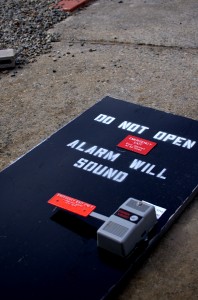There are many different types of locks and locking hardware available, and it’s not always easy to determine the difference between product types. On the surface, they may seem (and even look) similar, but as you learned when we discussed the difference between mortise and cylindrical locks, there’s often a huge difference. Today we dive into the variances between panic versus exit bars.
Panic Bar
A panic bar, sometimes referred to as a crash bar or panic device, is used for quickly unlocking a door during an emergency situation. Designed for life safety compliance, the mechanism consists of a spring-loaded metal bar fixed horizontally to the inside of an egress-opening door. When the lever is depressed, it activates a mechanism which unlatches the door. This actuation allows occupants to quickly exit from the building, avoiding delay and crowds, which are known to be highly hazardous in emergencies. So when is panic hardware required? The 2009 edition of the International Building Code requires panic hardware on buildings that are classified as Education (E), High Hazard (H), and Assembly (A) Occupancies along with an occupant load of 50 or more.
Exit Bar
 An exit device (exit hardware or exit bar) is a locking device consisting of a bar across the inside of a door. When the bar is pushed, the door latch is released. When the door is installed on occupancies other than E, H, and A with an occupant load of LESS THAN 50, a standard exit device is acceptable. Unlike panic bars, these devices can require a key or code to exit because code doesn’t require the life safety standards of panic hardware.
An exit device (exit hardware or exit bar) is a locking device consisting of a bar across the inside of a door. When the bar is pushed, the door latch is released. When the door is installed on occupancies other than E, H, and A with an occupant load of LESS THAN 50, a standard exit device is acceptable. Unlike panic bars, these devices can require a key or code to exit because code doesn’t require the life safety standards of panic hardware.

Just to confirm, any R or M occupancy with an occupant load over 50 does not require panic hardware no matter how high the occupant load is.
A 5 unit apartment building are you required to have an exit bar on the front door of the complex
you required to have an exit bar on the front door of the building
Hi Carol-
You would need to check with your local Authority Having Jurisdiction (AHJ). Call your county government and they can get you to the right person.
Hi folks, are there instances / examples where NOT having panic hardware is known to have caused injury or death? …instead of panic hardware maybe it was a door knob (requiring rotation) or door handle (required up or down movement). Looking for an example to help emphasize WHY panic hardware is important. Thanks
Hi, Mike. I asked Ian Greene, LockNet’s technical support engineer, if he knew of any incidents where not having panic hardware has caused injury or death and he brought up the Iroquois Theatre fire. Several people were killed because they had the fire exits barred and the ones that weren’t fire exits had locking devices people weren’t familiar with and couldn’t figure out how to open. This is why current fire codes require all exit doors be equipped with devices you can use without any “special knowledge” (i.e. a key, series of movements or actions, etc.) and are single motion egress. I hope this helps!